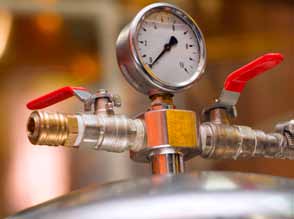The year 1980 was pretty much the real beginning of what has become the craft beer revolution here in this country. Ken Grossman, owner, founder and CEO of Sierra Nevada Brewing Co. of Chico, CA, plans to mark 2010 with a year-long celebration, in cooperation with Fritz Maytag and his San Francisco Anchor Brewery. To this end ,they invited myself and Charlie Papazian (Brewers Association of America) for a day at Anchor Brewery to plan a video and recipes for several special anniversary brews. Also invited were Jack McAuliffe, the founder, in 1976, of tiny New Albion Brewery, Sonoma, CA). McAuliffe’s effort was America’s first truly “micro” brewery, producing some 150-bbl (5,650 gallons) annually. He was unable to attend, but he did participate in the video.
When our friend Michael Jackson published his monumental tome, The World Guide to Beer, in 1976, we have to wonder if he had any idea what he had wrought.
The beers will be released periodically throughout the year, starting with the first release in March and continuing until Sierra Nevada’s 30th Anniversary on November 15, 2010. These limited release, 750ml cage-and-cork bottles will be available at select retailers and beer-centric bars, and they will be much more than a tribute. Proceeds from the project will go to benefit charities chosen by the four pioneers.

When we gathered together at Anchor last December, the film crew began interviewing us by discussing our backgrounds and input in the creations. Grossman told me, “We wanted to pay tribute to the original pioneers who helped me and hundreds of others get started.” It was a fascinating day for all of us.
We listened as Fritz Maytag, one of America’s foremost brewers, related how he had saved America’s last “steam beer” brewery. At that time (in 1965) Anchor was not only America’s smallest brewery, but became the only one making really distinctive beer.
Joe Allen, Anchor’s owner, had revived the brewery in 1933, after Prohibition. His beer was not always up to quality for distribution to the 25 or so San Francisco bars still serving it. In 1959, he retired, passing it on to Lawrence Steed and Bill Buck, who moved Anchor from the original Kansas Street location to a smaller, ramshackle, un-brewery-like warehouse under the freeway at 8th Street. By 1965, production was down to less than 700-bbls (21,700-gals).
It was by a twist of fate that Maytag discovered that the beer and the brewery were in trouble. Maytag, at 27, was just out of graduate school at Stanford, and not particularly enthused to return to the family’s dairy farm in Iowa, so he borrowed $15,000 to buy a major share in the brewery. Over time, as he learned more about brewing, he was able to concentrate on basics: all-malt brewing, steady temperatures and rigid quality controls. With hard work he managed to get greater production and distribution and, in 1971, he installed a bottling line. Production increased to 7,000 bbl (211,000 gals) by 1975. By 1979, the brewery moved to a new location at 1705 Mariposa Street with much better brewing equipment imported from Europe.
Maytag found that there is more to beer than water, malt and hops: there’s also character, taste and tradition to consider. He discovered the way to success lay in producing a unique and distinctive product. Today, Anchor is ranked 15th largest among American craft breweries, mostly because Maytag tries to keep his production low. He is not interested in high volume sales.
From Wine to Beer
As for me, I had given up on insipid U.S. beer and had switched to wine. I became interested in making wine during the fall of 1969, and was teaching a home winemaking class for Portland Community College at a now defunct fermentation supply store called Wine-Art Oregon. They had a good recipe using reconstituted grape extract and an excellent production system featuring primary and secondary fermentation. The result was a good cheap product with almost no fermentation problems.
Wine-Art was part of a Canadian chain, whose founder, Stan Anderson, was also the author of a very interesting homebrew recipe featuring primary and secondary fermentation methods, and the actual addition of hops in a real kettle boil. This from water and malt extract syrup only, and little, if any, sugar, quite a difference from traditional homebrew recipes at the time. The resulting beer was very acceptable with none of the off-flavors that were so annoying about traditional recipes. Moreover, one could actually add ground malted barley directly to the kettle for a more authentic product. All of the ingredients were available at the Wine-Art store.
My first batch was a great success: it was a warm-fermented lager beer, not one of the English style ale brews described in the British homebrewing books they sold, but the recipe was a little disorganized so I re-wrote it. Owner Jack McCallum liked my new version of the recipe, and suggested I write a book. That was the last thing I’d had on my mind. I’d never written a book before and for a lazy person like myself, it sounded like a tremendous amount of work, but he kept telling me to get busy. A Treatise on Lager Beer (his title) was only 58 pages, but it proved quite successful (seven editions and 110,000 copies). It took me three months to write, which I did while sipping profuse amounts of cheap vin rose.
Out in Boulder, CO, a budding nuclear engineer turned kindergarten teacher obtained a copy and made good beer. Charlie Papazian started teaching homebrewing, in his home, to classes of up to 20. Before long, he started the American Homebrewers Association, and good homebrewed beer became evermore available. Today, he also heads the Brewers Association, publishing The New Brewer and Zymurgy magazines as well.










